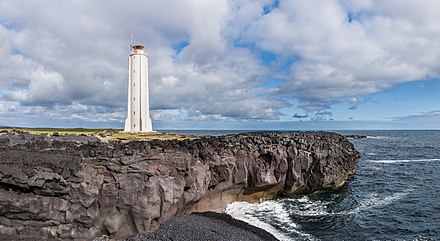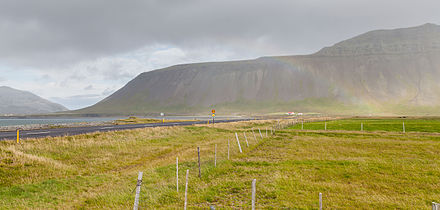West Iceland - region in Iceland
West Iceland (Icelandic: <span dir="ltr" lang="is">Vesturland</span>) is the region of Iceland north of the capital.
Towns
Listed from south to north:
- Borgarnes and Borgarbyggð – a town by Borgarfjörður about an hour and a half from Reykjavík by car and its municipality. Borgarnes used to be a service centre for the neighbouring farming communities, but has a developed tourist industry and is a good place to stay for those wanting to get out of Reykjavík while remaining close to the south-west corner.
- Stykkishólmur – the largest town on Snæfellsnes and gateway to the islands of Breiðafjörður. Has many houses of Danish influence dating back to the 18th and 19th centuries.
- Grundarfjörður – to the west of Stykkishólmur, on the north coast of Snæfellsnes.
- Hellissandur , Rif and Ólafsvík – three villages on the western end of Snæfellsnes, close to Snæfellsjökull and the national park.
- Búðardalur – small village in Dalirnir, known for its cheese production.
Other destinations
- Reykholt – former home of Snorri Sturluson, medieval poet, author and chieftain.
- Snæfellsjökull National Park - on the tip of the Snæfellsnes Peninsula in southern Iceland, this park is home to the ice-covered volcanic crater that was the setting for Jules Verne's book Journey to the Center of the Earth.
- Flatey – the largest island in Breiðafjörður, and the only one that is inhabited.
- Ok — A shield volcano and former glacier. There is a memorial plaque for the glacier, dated 2019, with the inscription "Ok is the first Icelandic glacier to lose its status as a glacier. In the next 200 years all our glaciers are expected to follow the same path. This monument is to acknowledge that we know what is happening and what needs to be done. Only you know if we did it."
Understand
West Iceland can be split into four main areas. Furthest north are Dalirnir (The Valleys), a farming area mainly seen by tourists driving through on their way to North Iceland. Dalirnir contain a remarkable natural phenomenon, though: The hills. There are many of them. Very many in fact. And some of the hills have hills on top of them. Icelandic legend has it that the hills are so many that they're uncountable.
A second uncountable phenomenon is found to the west of Dalirnir. Breiðafjörður is a large bay scattered with a supposedly uncountable number of small islands. In earlier times these islands were all used for farming purposes, but today only one of them is inhabited, the island of Flatey.
South of Breiðafjörður is a large, long peninsula. Snæfellsnes is one long mountain range with stunning, if barren, beauty. Dotted along the coastline are fishing communities, with farming taking place on the little lowland regions found between the coast and the mountains.
Finally, to the south of Snæfellsnes, there is the farming area surrounding Borgarfjörður. This is an important agricultural area, reaching far inland. Borg, the farm after which both Borgarfjörður and the town of Borgarnes are named, was the home of Egill Skallagrímsson, the titular character of Egil's Saga. Further inland, Reykholt was home to Snorri Sturluson, one of the most important players in Iceland's 14th-century civil war and chronicler of Norwegian kings. Today the area is home to two universities, the Icelandic University of Agriculture and Bifröst University.
Get in
West Iceland is linked to Southwest and North Iceland via the ring road. If you are arriving from Reykjavík, you will most likely go through a tunnel under Hvalfjörður (the fjord marking the start of West Iceland). Taking a detour around Hvalfjörður instead is a scenic drive, and well worth it if you have the time. Since the tunnel was built, the traffic levels are very low and sights include the country's only whaling station in operation as well as innumerable waterfalls, mountains and rivers. However it's a long drive, 59 km, as opposed to the 6-km long tunnel.
If you're arriving from the Westfjords, there are two roads, one on each coast of the peninsula that links the regions. Or you can take a ferry from Brjánslækur, on the south coast of the Westfjords, called Baldur (dead link: January 2023). Brjánslækur is only a ferry port and the closest towns are Bíldudalur and Patreksfjörður, both around 50 km away. The terminal on the West Iceland side of the route is Stykkishólmur on Snæfellsnes, with a stop in Flatey on the way.
There are no scheduled flights into West Iceland.
Get around
Roads mainly trace the coastline in West Iceland, with a few mountain passes and more inland roads in the rural area northeast of Borgarfjörður. The Ring Road bypasses large sections of the region, including Snæfellsnes and Dalirnir, meaning traffic can be very light. Although most roads are paved, the very tip of the Snæfellsnes peninsula is not, nor are some of the mountain passes. In some places, the road on Snæfellsnes sits on a very narrow ledge, with a long and steep fall to the sea below.
Driving on your own is the most flexible way of getting around, but there are some bus routes operated by Straeto. Hitch hiking is an option for those travelling by bus who want to reach destinations not served by the bus system.
To get to the islands of Breiðafjörður, a boat is needed. Only Flatey is served by regular ferries from Stykkishólmur, crossing over to Brjánslækur on the south coast of the Westfjords. If you wish to visit other islands you will need to arrange transportation locally, but frankly most of them are small and without much to see.
See

Natural beauty is the main attraction of the region, particularly Snæfellsnes and the islands of Breiðafjörður.
- Deildartunguhver – Europe's biggest hot spring, measured in amounts of water. Close to Reykholt.
- Snæfellsnes – a magnificent mountain range that forms a peninsula separating the bays of Faxaflói and Breiðafjörður. A trip around the peninsula will allow you to see the ocean and the mountains. Many waterfalls come out of the mountain cliffs and there are a number of beautiful rivers running from the mountains into the ocean.
Do
- The islands of Breiðafjörður – according to Icelandic legend, the islands of Breiðafjörður are so many that they're uncountable. Sightseeing trips are available from Stykkishólmur as are tours to some of the larger islands.
- Glacier tours – go to the top of Snæfellsjökull glacier. You can get a ride in special trucks, or simply hike up on your own. Remember to pack sunglasses!
- Danish days – the town festival in Stykkishólmur held each August, celebrating the town's historic links to Denmark.
- Horse riding. The farm of Lýsuhóll on Snæfellsnes offers horse rentals where you can ride Icelandic horses on the Snæfellsnes coast.
- Hiking. Snæfellsnes is ideal land for hikers, with its many mountains.
Eat
West Iceland is not traditionally a culinary destination, even by Icelandic standards. However there is some important food production. Snæfellsnes is a fishing area, so look for fresh fish, especially in the small villages on the western end of the peninsula. Búðardalur is known in Iceland for its cheese production, although the cheese produced are generally not of a local type (brie, cheddar etc.). There are geothermal areas in the vicinity of Borgarfjörður, and by extension there is greenhouse farming. Sometimes it will be possible to buy vegetables direct from the farmer and there's a popular stall selling tomatoes by Deildartunguhver.
Most villages will have some restaurants, but there are also some interesting rural eating options with fantastic scenery . These include Hótel Búðir (fine dining) and Fjöruhúsið (a small café), both on the southern coast of Snæfellsnes.
Drink
West Iceland has a local beer, and a local vodka. The beer is called Jökull and brewed by Mjöður Brugghús in Stykkishólmur. Reyka Vodka is distilled in Borgarnes.
As everywhere in Iceland, alcohol can only be bought in Vínbúðin. This can be interesting in some of the smaller villages and in Ólafsvík the liquor store is also a baby clothes store.
Stay safe
Don't worry about crime - you probably won't see very many people at all. The biggest risk is falling off the road. Especially going up the mountain, be careful and watch for oncoming traffic.
As the peninsula sticks directly into the Atlantic, the area tends to be very windy.
